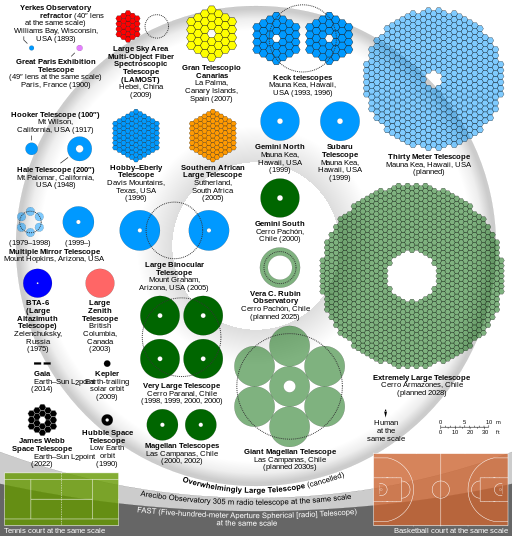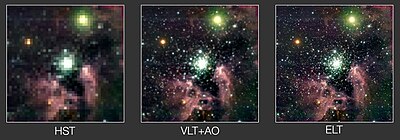Comparison optical telescope primary mirrors
The telescopes shown on this comparison chart are listed below, ordered in each sub-section by (effective) mirror/lens area, low to high, and then by actual/planned first light date, old to new. The "present-day" status is given as of the beginning of 2024. See also List of largest optical reflecting telescopes.
Largest refractors (for comparison):
- 1) Yerkes Observatory's 40-inch (1.02 m) refractor, 1893 (largest refractor consistently used for scientific observations)
- 2) Great Paris Exhibition Telescope, 49 inches (1.24 m), 1900 (largest refractor ever built; had practically no scientific usage)
Ground-based reflectors:
- 3) Hooker Telescope, 100 inches (2.54 m), 1917; world's largest telescope from 1917 to 1949
- 4) Multiple Mirror Telescope, 186 inches (4.72 m) effective, 1979–1998; 6.5 m, from 1998
- 5) LAMOST (Large Sky Area Multi-Object Fiber Spectroscopic Telescope), 4.9 m effective at best, 2009
- 6) Hale Telescope, 200 inches (5.1 m), 1949; world's largest telescope from 1949 to 1975
- 7) BTA-6, 6 m, 1975; world's largest telescope from 1975 to 1990 (when it was surpassed by the partially-completed Keck I telescope)
- 8) Large Zenith Telescope, 6 m, 2003; largest liquid-mirror telescope ever built; decommissioned in 2019
- 9) Magellan Telescopes, two 6.5‑m individual telescopes, 2000 and 2002;
- 10) Vera C. Rubin Observatory (formerly Large Synoptic Survey Telescope), 6.68 m effective (8.4‑m mirror, but with a big hole in the middle), planned 2025
- 11) Gemini Observatory, 8.1 m, 1999 and 2001
- 12) Subaru Telescope, 8.2 m, 1999; largest monolithic (i.e. non-segmented) mirror in an optical telescope from 1999 to 2005
- 13) Southern African Large Telescope, 9.2 m effective, 2005 (largest optical telescope in the southern hemisphere)
- 14) Hobby–Eberly Telescope, 10 m effective, 1996
- 15) Gran Telescopio Canarias, 10.4 m, 2007 (world's largest single-aperture optical telescope)
- 16) Large Binocular Telescope, 11.8 m effective (two 8.4‑m telescopes on a common mount), 2005 and 2006; each individual telescope has the largest monolithic (i.e. non-segmented) mirror in an optical telescope, while the combined effective light collecting area is the largest for any optical telescope in non-interferometric mode
- 17) Keck Telescopes, 14 m effective (two 10‑m individual telescopes), 1993 and 1996; similarly to VLT, the two telescopes were combined only for interferometric observations rather than to simply achieve larger light collecting area; furthermore, this mode has been discontinued
- 18) Very Large Telescope, 16.4 m effective (four 8.2 m individual telescopes), 1998, 1999, 2000, and 2000; total effective light collecting area would have been world's largest for any present-day optical telescope, but the instrumentation required to obtain a combined incoherent focus was not built
- 19) Giant Magellan Telescope, 22.0 m effective, planned for early 2030s
- 20) Thirty Meter Telescope, 30 m effective, planned (no specific dates yet)
- 21) Extremely Large Telescope, 39.3 m effective, planned 2028
- 22) Overwhelmingly Large Telescope, 100 m, cancelled
Space telescopes:
- 23) Gaia, 1.45 m × 0.5 m (area equivalent to a 0.96‑m round mirror), 2013
- 24) Kepler, 1.4 m, 2009
- 25) Hubble Space Telescope, 2.4 m, 1990
- 26) James Webb Space Telescope, 6.5 m effective, 2022 (largest space optical telescope to date)
Radio telescopes for comparison:
- 27) Arecibo Observatory's 305‑m dish; largest fully-filled single-aperture telescope from 1963 to 2016 (the largest-aperture telescope of any kind is the very-sparsely-filled RATAN-600 radio telescope)
- 28) Five-hundred-meter Aperture Spherical [radio] Telescope (FAST), 500‑m dish (effective aperture of ≈300 m), 2016; world's largest fully-filled single-aperture telescope (since 2016)
Other objects for comparison:
- 29) Human height, 1.77 m on average
- 30) Tennis court, 78 × 36 ft (23.77 × 10.97 m)
- 31) Basketball court, 94 × 50 ft (28.7 × 15.2 m)
Relevantní obrázky
Relevantní články
DalekohledOptický dalekohled či teleskop je přístroj k optickému přiblížení pomocí dvou soustav čoček nebo zrcadel: objektivu a okuláru, jímž se obraz pozoruje. .. pokračovat ve čtení
Extrémně velký dalekohledExtrémně velký dalekohled je připravovaný největší dalekohled na světě. Na hoře Cerro Armazones v severní Chile jej staví Evropská jižní observatoř (ESO). Jeho základní kámen byl položen v květnu 2017; s uvedením do provozu se počítá po roce 2028. .. pokračovat ve čtení























